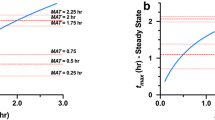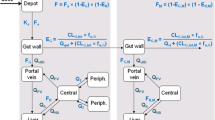Abstract
Purpose
Existing PBPK models incorporating intestinal first-pass metabolism account for effect of drug permeability on accessible absorption surface area by use of “effective” permeability, P eff , without adjusting number of enterocytes involved in absorption or proportion of intestinal CYP3A involved in metabolism. The current model expands on existing models by accounting for these factors.
Methods
The PBPK model was developed using SAAM II. Midazolam clinical data was generated at GlaxoSmithKline.
Results
The model simultaneously captures human midazolam blood concentration profile and previously reported intestinal availability, using values for CYP3A CLu int , permeability and accessible surface area comparable to literature data. Simulations show: (1) failure to distinguish absorbing from non-absorbing enterocytes results in overestimation of intestinal metabolism of highly permeable drugs absorbed across the top portion of the villous surface only; (2) first-pass extraction of poorly permeable drugs occurs primarily in enterocytes, drugs with higher permeability are extracted by enterocytes and hepatocytes; (3) CYP3A distribution along crypt-villous axes does not significantly impact intestinal metabolism; (4) differences in permeability of perpetrator and victim drugs results in their spatial separation along the villous axis and intestinal length, diminishing drug-drug interaction magnitude.
Conclusions
The model provides a useful tool to interrogate intestinal absorption/metabolism of candidate drugs.










Similar content being viewed by others
Abbreviations
- AUC :
-
area under the curve
- CL :
-
clearance
- F :
-
oral bioavailability
- F g :
-
intestinal availability
- F h :
-
hepatic availability
- f ub :
-
free fraction in blood
- f ue :
-
free fraction in enterocyte
- f uh :
-
free fraction in hepatocyte
- HLQ :
-
higher limit of quantitation
- ICRP:
-
the International Commission on Radiological Protection
- LC/MS/MS:
-
high performance liquid chromatography with tandem mass spectrometry
- LLQ :
-
lower limit of quantitation
- PBPK:
-
physiologically-based pharmacokinetics model
- P eff :
-
effective permeability
- P-gp:
-
P-glycoprotein
References
Wienkers LC, Heath TG. Predicting in vivo drug interactions from in vitro drug discovery data. Nat Rev Drug Discov. 2005;4:825–33.
Peters SA, Schroeder PE, Giri N, Dolgos H. Evaluation of the use of static and dynamic models to predict drug-drug interaction and its associated variability: impact on drug discovery and early development. Drug Metab Dispos. 2012;40:1495–507.
Einolf HJ. Comparison of different approaches to predict metabolic drug-drug interactions. Xenobiotica. 2007;37:1257–94.
Paine MF, Khalighi M, Fisher JM, Shen DD, Kunze KL, Marsh CL, et al. Characterization of interintestinal and intraintestinal variations in human CYP3A-dependent metabolism. J Pharmacol Exp Ther. 1997;283:1552–62.
Yang J, Tucker GT, Rostami-Hodjegan A. Cytochrome P450 3A expression and activity in the human small intestine. Clin Pharmacol Ther. 2004;76:391.
Paine MF, Shen DD, Kunze KL, Perkins JD, Marsh CL, McVicar JP, et al. First-pass metabolism of midazolam by the human intestine. Clin Pharmacol Ther. 1996;60:14–24.
Yang J, Jamei M, Yeo KR, Tucker GT, Rostami-Hodjegan A. Prediction of intestinal first-pass drug metabolism. Curr Drug Metab. 2007;8:676–84.
Cong D, Doherty M, Pang KS. A new physiologically based, segregated-flow model to explain route-dependent intestinal metabolism. Drug Metab Dispos. 2000;28:224–35.
Gertz M, Houston JB, Galetin A. Physiologically based pharmacokinetic modeling of intestinal first-pass metabolism of CYP3A substrates with high intestinal extraction. Drug Metab Dispos. 2011;39:1633–42.
Tam D, Tirona RG, Pang KS. Segmental intestinal transporters and metabolic enzymes on intestinal drug absorption. Drug Metab Dispos. 2003;31:373–83.
Lennernas H. Human intestinal permeability. J Pharm Sci. 1998;87:403–10.
Pappenheimer JR, Michel CC. Role of villus microcirculation in intestinal absorption of glucose: coupling of epithelial with endothelial transport. J Physiol. 2003;553:561–74.
Oliver RE, Jones AF, Rowland M. What surface of the intestinal epithelium is effectively available to permeating drugs? J Pharm Sci. 1998;87:634–9.
Cubitt HE, Yeo KR, Howgate EM, Rostami-Hodjegan A, Barter ZE. Sources of interindividual variability in IVIVE of clearance: an investigation into the prediction of benzodiazepine clearance using a mechanistic population-based pharmacokinetic model. Xenobiotica. 2011;41:623–38.
Thummel KE, O’Shea D, Paine MF, Shen DD, Kunze KL, Perkins JD, et al. Oral first-pass elimination of midazolam involves both gastrointestinal and hepatic CYP3A-mediated metabolism. Clin Pharmacol Ther. 1996;59:491–502.
DeSesso JM, Jacobson CF. Anatomical and physiological parameters affecting gastrointestinal absorption in humans and rats. Food Chem Toxicol. 2001;39:209–28.
Krogh A. The progress of physiology. Science. 1929;70:200–4.
Casley-Smith JR, O’Donoghue PJ, Crocker KW. The quantitative relationships between fenestrae in jejunal capillaries and connective tissue channels: proof of “tunnel-capillaries”. Microvasc Res. 1975;9:78–100.
Buddington RK, Diamond JM. Ontogenetic development of intestinal nutrient transporters. Annu Rev Physiol. 1989;51:601–19.
Blouin A, Bolender RP, Weibel ER. Distribution of organelles and membranes between hepatocytes and nonhepatocytes in the rat liver parenchyma. A stereological study. J Cell Biol. 1977;72:441–55.
Keppler D, Arias IM. Hepatic canalicular membrane. Introduction: transport across the hepatocyte canalicular membrane. FASEB J. 1997;11:15–8.
Strocchi A, Levitt MD. Role of villous surface area in absorption. Science versus religion. Dig Dis Sci. 1993;38:385–7.
Backman JT, Kivisto KT, Olkkola KT, Neuvonen PJ. The area under the plasma concentration-time curve for oral midazolam is 400-fold larger during treatment with itraconazole than with rifampicin. Eur J Clin Pharmacol. 1998;54:53–8.
Kupferschmidt HH, Ha HR, Ziegler WH, Meier PJ, Krahenbuhl S. Interaction between grapefruit juice and midazolam in humans. Clin Pharmacol Ther. 1995;58:20–8.
Palkama VJ, Ahonen J, Neuvonen PJ, Olkkola KT. Effect of saquinavir on the pharmacokinetics and pharmacodynamics of oral and intravenous midazolam. Clin Pharmacol Ther. 1999;66:33–9.
Saari TI, Laine K, Leino K, Valtonen M, Neuvonen PJ, Olkkola KT. Effect of voriconazole on the pharmacokinetics and pharmacodynamics of intravenous and oral midazolam. Clin Pharmacol Ther. 2006;79:362–70.
Gertz M, Harrison A, Houston JB, Galetin A. Prediction of human intestinal first-pass metabolism of 25 CYP3A substrates from in vitro clearance and permeability data. Drug Metab Dispos. 2010;38:1147–58.
Obach RS. Prediction of human clearance of twenty-nine drugs from hepatic microsomal intrinsic clearance data: an examination of in Vitro half-life approach and nonspecific binding to microsomes. Drug Metab Dispos. 1999;27:1350–9.
Fisher JM, Wrighton SA, Watkins PB, Schmiedlin-Ren P, Calamia JC, Shen DD, et al. First-pass midazolam metabolism catalyzed by 1alpha,25-dihydroxy vitamin D3-modified Caco-2 cell monolayers. J Pharmacol Exp Ther. 1999;289:1134–42.
Tolle-Sander S, Rautio J, Wring S, Polli JW, Polli JE. Midazolam exhibits characteristics of a highly permeable P-glycoprotein substrate. Pharm Res. 2003;20:757–64.
Polli JW, Wring SA, Humphreys JE, Huang L, Morgan JB, Webster LO, et al. Rational use of in vitro P-glycoprotein assays in drug discovery. J Pharmacol Exp Ther. 2001;299:620–8.
Obach RS, Baxter JG, Liston TE, Silber BM, Jones BC, MacIntyre F, et al. The prediction of human pharmacokinetic parameters from preclinical and in vitro metabolism data. J Pharmacol Exp Ther. 1997;283:46–58.
Chen EP, Chen L, Ji Y, Tai G, Wen YH, Ellens H. A mechanism-based mathematical model of aryl hydrocarbon receptor-mediated CYP1A induction in rats using beta-naphthoflavone as a tool compound. Drug Metab Dispos. 2010;38:2278–85.
Tucker TG, Milne AM, Fournel-Gigleux S, Fenner KS, Coughtrie MW. Absolute immunoquantification of the expression of ABC transporters P-glycoprotein, breast cancer resistance protein and multidrug resistance-associated protein 2 in human liver and duodenum. Biochem Pharmacol. 2012;83:279–85.
Fan J, Maeng HJ, Pang KS. Interplay of transporters and enzymes in the Caco-2 cell monolayer: I. effect of altered apical secretion. Biopharm Drug Dispos. 2010;31:215–27.
Kalvass JC, Pollack GM. Kinetic considerations for the quantitative assessment of efflux activity and inhibition: implications for understanding and predicting the effects of efflux inhibition. Pharm Res. 2007;24:265–76.
Lumen AA, Acharya P, Polli JW, Ayrton A, Ellens H, Bentz J. If the KI is defined by the free energy of binding to P-glycoprotein, which kinetic parameters define the IC50 for the Madin-Darby canine kidney II cell line overexpressing human multidrug resistance 1 confluent cell monolayer? Drug Metab Dispos. 2010;38:260–9.
Tachibana T, Kato M, Takano J, Sugiyama Y. Predicting drug-drug interactions involving the inhibition of intestinal CYP3A4 and P-glycoprotein. Curr Drug Metab. 2010;11:762–77.
Tran TT, Mittal A, Aldinger T, Polli JW, Ayrton A, Ellens H, et al. The elementary mass action rate constants of P-gp transport for a confluent monolayer of MDCKII-hMDR1 cells. Biophys J. 2005;88:715–38.
Fihn BM, Sjoqvist A, Jodal M. Permeability of the rat small intestinal epithelium along the villus-crypt axis: effects of glucose transport. Gastroenterology. 2000;119:1029–36.
Meddings JB, DeSouza D, Goel M, Thiesen S. Glucose transport and microvillus membrane physical properties along the crypt-villus axis of the rabbit. J Clin Invest. 1990;85:1099–107.
Meyers MB, Scotto KW, Sirotnak FM. P-glycoprotein content and mediation of vincristine efflux: correlation with the level of differentiation in luminal epithelium of mouse small intestine. Cancer Commun. 1991;3:159–65.
Yu LX, Lipka E, Crison JR, Amidon GL. Transport approaches to the biopharmaceutical design of oral drug delivery systems: prediction of intestinal absorption. Adv Drug Deliv Rev. 1996;19(3):359–76.
Chaudhuri TK. Use of 99mTc-DTPA for measuring gastric emptying time. J Nucl Med. 1974;15(6):1–5.
Fenneteau F, Poulin P, Nekka F. Physiologically based predictions of the impact of inhibition of intestinal and hepatic metabolism on human pharmacokinetics of CYP3A substrates. J Pharm Sci. 2010;99(1):486–514.
Brown RP, Delp MD, Rhomberg SL, Beliles RP. Physiological parameter values for physiologically based pharmacokinetic models. Toxicol Ind Health. 1997;13(4):407–84.
van Richter O, Burk O, Fromm MF, Thon KP, Eichelbaum M, Kivisto KT. Cytochrome P450 3A4 and P-glycoprotein expression in human small intestinal enterocytes and hepatocytes: a comparative analysis in paired tissue. Clin Pharmacol Ther. 2004;75(3):172–83.
Tabbaa MG, Axon ATR, Dixon MF. Enterocyte dimensions in patients with abnormal intestinal permeability. Eur J Gastroenterol Hepatol. 1994;6:607–10.
Author information
Authors and Affiliations
Corresponding author
Rights and permissions
About this article
Cite this article
Chen, E.P., Tai, G. & Ellens, H. The Importance of Villous Physiology and Morphology in Mechanistic Physiologically-Based Pharmacokinetic Models. Pharm Res 31, 305–321 (2014). https://doi.org/10.1007/s11095-013-1161-x
Received:
Accepted:
Published:
Issue Date:
DOI: https://doi.org/10.1007/s11095-013-1161-x




